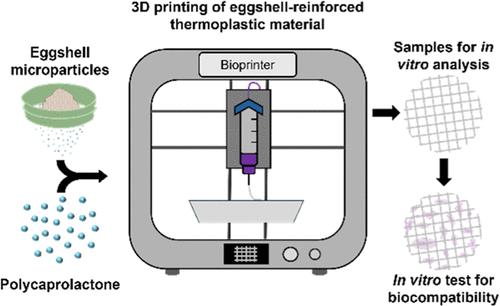当前位置:
X-MOL 学术
›
ACS Appl. Mater. Interfaces
›
论文详情
Our official English website, www.x-mol.net, welcomes your
feedback! (Note: you will need to create a separate account there.)
3D Printed Eggshell Microparticle-Laden Thermoplastic Scaffolds for Bone Tissue Engineering
ACS Applied Materials & Interfaces ( IF 8.3 ) Pub Date : 2024-06-17 , DOI: 10.1021/acsami.4c02800 Mert Gezek 1, 2 , Mine Altunbek 1 , Maria Eduarda Torres Gouveia 1 , Gulden Camci-Unal 1, 3
ACS Applied Materials & Interfaces ( IF 8.3 ) Pub Date : 2024-06-17 , DOI: 10.1021/acsami.4c02800 Mert Gezek 1, 2 , Mine Altunbek 1 , Maria Eduarda Torres Gouveia 1 , Gulden Camci-Unal 1, 3
Affiliation

|
Three-dimensional (3D) printing, an additive manufacturing technique, is increasingly used in the field of tissue engineering. The ability to create complex structures with high precision makes the 3D printing of this material a preferred method for constructing personalized and functional materials. However, the challenge lies in developing affordable and accessible materials with the desired physiochemical and biological properties. In this study, we used eggshell microparticles (ESPs), an example of bioceramic and unconventional biomaterials, to reinforce thermoplastic poly(ε-caprolactone) (PCL) scaffolds via extrusion-based 3D printing. The goal was to conceive a sustainable, affordable, and unique personalized medicine approach. The scaffolds were fabricated with varying concentrations of eggshells, ranging from 0 to 50% (w/w) in the PCL scaffolds. To assess the physicochemical properties, we employed scanning electron microscopy, Fourier-transform infrared spectroscopy, thermogravimetric analysis, differential scanning calorimetry, and X-ray diffraction analysis. Mechanical properties were evaluated through compression testing, and degradation kinetics were studied through accelerated degradation with the remaining mass ranging between 89.4 and 28.3%. In vitro, we evaluated the characteristics of the scaffolds using the MC3T3-E1 preosteoblasts over a 14 day period. In vitro characterization involved the use of the Alamar blue assay, confocal imaging, and real-time quantitative polymerase chain reaction. The results of this study demonstrate the potential of 3D printed biocomposite scaffolds, consisting of thermoplastic PCL reinforced with ESPs, as a promising alternative for bone-graft applications.
中文翻译:

用于骨组织工程的 3D 打印蛋壳微粒负载热塑性支架
三维(3D)打印作为一种增材制造技术,越来越多地应用于组织工程领域。高精度创建复杂结构的能力使得这种材料的 3D 打印成为构建个性化和功能性材料的首选方法。然而,挑战在于开发具有所需理化和生物特性的负担得起且易于获得的材料。在这项研究中,我们使用蛋壳微粒 (ESP)(生物陶瓷和非常规生物材料的一个例子)通过基于挤出的 3D 打印来增强热塑性聚(ε-己内酯)(PCL)支架。目标是构思一种可持续、负担得起且独特的个性化医疗方法。该支架由不同浓度的蛋壳制成,PCL 支架中的蛋壳浓度范围为 0 至 50%(w/w)。为了评估物理化学性质,我们采用了扫描电子显微镜、傅里叶变换红外光谱、热重分析、差示扫描量热法和 X 射线衍射分析。通过压缩测试评估机械性能,并通过加速降解研究降解动力学,剩余质量在89.4%至28.3%之间。在体外,我们使用 MC3T3-E1 前成骨细胞在 14 天的时间内评估了支架的特性。体外表征涉及使用阿拉玛蓝测定、共焦成像和实时定量聚合酶链反应。这项研究的结果证明了 3D 打印生物复合材料支架(由 ESP 增强的热塑性 PCL 组成)作为骨移植应用的有前途的替代品的潜力。
更新日期:2024-06-17
中文翻译:

用于骨组织工程的 3D 打印蛋壳微粒负载热塑性支架
三维(3D)打印作为一种增材制造技术,越来越多地应用于组织工程领域。高精度创建复杂结构的能力使得这种材料的 3D 打印成为构建个性化和功能性材料的首选方法。然而,挑战在于开发具有所需理化和生物特性的负担得起且易于获得的材料。在这项研究中,我们使用蛋壳微粒 (ESP)(生物陶瓷和非常规生物材料的一个例子)通过基于挤出的 3D 打印来增强热塑性聚(ε-己内酯)(PCL)支架。目标是构思一种可持续、负担得起且独特的个性化医疗方法。该支架由不同浓度的蛋壳制成,PCL 支架中的蛋壳浓度范围为 0 至 50%(w/w)。为了评估物理化学性质,我们采用了扫描电子显微镜、傅里叶变换红外光谱、热重分析、差示扫描量热法和 X 射线衍射分析。通过压缩测试评估机械性能,并通过加速降解研究降解动力学,剩余质量在89.4%至28.3%之间。在体外,我们使用 MC3T3-E1 前成骨细胞在 14 天的时间内评估了支架的特性。体外表征涉及使用阿拉玛蓝测定、共焦成像和实时定量聚合酶链反应。这项研究的结果证明了 3D 打印生物复合材料支架(由 ESP 增强的热塑性 PCL 组成)作为骨移植应用的有前途的替代品的潜力。





















































 京公网安备 11010802027423号
京公网安备 11010802027423号